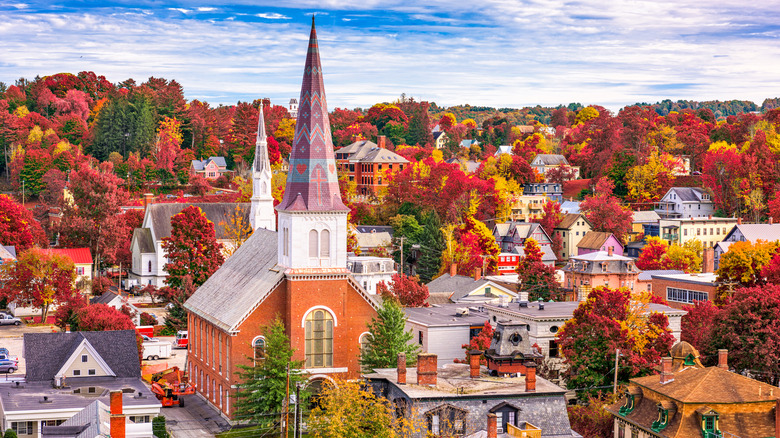The 10 States Where People Live The Longest, Ranked
There are many things that can impact one's health and, by extension, one's life expectancy. Diet and exercise often come up as important factors when it comes to good health. However, information from the CDC points out that where a person lives might also impact that person's life expectancy.
The CDC released the U.S. State Life Tables, 2020, which is one of their National Vital Statistics Reports. Now, you might be thinking, "Why are you showing the results of the 2020 one of these tables when it's 2024?" At this time of this publication, this is the latest of the U.S. State Life Tables available from the CDC. It shows the life expectancy of each state, as well as the District of Columbia. These State Life Tables are broken down into three categories: life expectancy for the total population; life expectancy for just the male population; and life expectancy for just the female population.
Our ranking of the top 10 states is exactly the same as the CDC's ranking of the top 10 states according to their respective total population's life expectancy. However, we will also cover the male and female population categories, as well as other state-specific health-related rankings.
10. Connecticut
Coming in at number 10 in the CDC's rankings is Connecticut. Per the data, people in this state are expected to live 78.4 years. However, the CDC also notes that the number of years females in Connecticut are expected to live is 81.3 years, and ranks Connecticut ninth in terms of female life expectancy. Connecticut ranks twelfth in terms of male life expectancy, since males living there are expected to live to 75.6 years.
Forbes also ranked the 50 states in terms of the health of the state's populations, and placed Connecticut at number three not only in terms of which state is healthiest, but also in terms of "disease risk factors and prevalence." Forbes' ranking, which was updated in January of 2024, placed Connecticut in sixth place in terms of people there having the longest life expectancy. Forbes also ranked the mortality rate for specific health conditions and identified Connecticut as having the lowest of all 50 states when it comes to diabetes. Forbes also ranked Connecticut as having the fourth-lowest respiratory disease mortality rate and stroke mortality rate, respectively.
Furthermore, SeniorLiving.org notes that more than most seniors living in Connecticut have never had heart disease (88.29%), asthma (88.23%), or COPD (88.09%). Likewise, the majority of seniors in this state have never had kidney disease (94.36%) or a stroke (93.78%), and close to 90% have never had a heart attack.
9. Utah
The CDC ranks Utah at number nine, with the total population's life expectancy at 78.6 years. The state is ranked fourth by the CDC in terms of male life expectancy, which is 76.7 years. However, it comes in at number 15 for female life expectancy, which the CDC has at 80.6 years.
Forbes considered 21 metrics to rank the states based on the health of their populations. This ranking, which was updated on January 8, 2024, had Utah in second place regarding the state's population's health. Forbes rankings also explored categories like how often adults in each state exercise and found that adults in the state "were second least likely to report that they did not exercise in the past month." Forbes also found a low percentage of adults in Utah are heavy drinkers, the fourth lowest of all the states. In the same vein, Utah topped the ranks as the state with the least number of adults who smoke.
In addition, Forbes ranked the states in terms of specific health concerns and found that Utah has low percentages of adults who have high blood pressure (ranking second lowest of the states) and high cholesterol (ranking fourth lowest). Forbes also found that Utah has the lowest cancer death rate among all the states.
8. Oregon
According to the CDC, the life expectancy for Oregon's total population is 78.8 years, and it ranks this state eighth. The CDC also ranks Oregon eighth when it comes to the life expectancy of its female population (81.3 years) and seventh for the life expectancy of its male population (76.3 years).
This isn't the only time the CDC has put out a report on life expectancy that involves Oregon. The CDC's State-Specific Healthy Life Expectancy at Age 65 Years – United States, 2007-2009 indicated not only how long on average someone would live past 65 years old in different states, but also how many of those years a person is expected to be healthy. The report estimated that people in Oregon would live 19.3 years past 65 on average and would be healthy for 15 of those years. Dr. Elizabeth Eckstrom, a geriatrician at Oregon Health and Science University, told Oregon Live in 2013 that a possible reason why members of the "older Oregonians" community are healthier is because cities in Oregon like Salem and Portland have become "more walkable and livable."
Additionally, SeniorLiving.org notes "general correlation between seniors' health and their physical activity by state" and named Oregon as one of the top three states in the categorization of "most active locations for seniors." Also, per the site, 93.07% of seniors in Oregon have not had kidney disease.
7. Vermont
The life expectancy of Vermont's total population is 78.8 years, according to the CDC, which puts Vermont at number seven. However, it's ranked by the CDC as sixth in terms of female life expectancy (81.4 years). Male life expectancy in Vermont is still within the top ten (ninth to be exact), with males living in Vermont expected to live to 76.1 years.
The United Health Foundation's 2011 America's Health Rankings ranked Vermont as the healthiest state, making it the fifth consecutive year that Vermont had this ranking, via Reuters. According to Reuters, a contributing factor to Vermont's ranking was a low incidence of infectious disease. Education was also ranked at a high rate for Vermont, which was an element of their ranking. In fact, the report, which is published on an annual basis by the United Health Foundation, American Public Health Association, and Partnership for Prevention, uses data from both the CDC and the Census Bureau, but also the U.S. Department of Education.
Furthermore, Northeastern Vermont Regional Hospital reported in December 2019 that Vermont topped the list again in the 30th edition of America's Health Rankings Annual Report. The report noted low incidents of chlamydia for the state, as well as the need to lower its rate of pertussis (whooping cough).
6. New Hampshire
Number six on the CDC's list is New Hampshire, with those living there expected to reach 79 years of age. In addition, New Hampshire ranks fifth in terms of both male and female life expectancies. With that said, males in New Hampshire are expected to live 76.5 years, while females are expected to live 81.5 years.
According to reporting by CNBC in 2018, SeniorLiving.org used data from the CDC and found that the healthiest 65-year-olds and older people living in the U.S. are in New Hampshire. This data from 2016, which was the most recent available at the time of the article, came from phone interviews. The total number of adults contacted to participate in these interviews was more than 400,000. In the end, 83% of those 65 and older described their health in positive terms.
The SeniorLiving.org website also has information regarding the states and seniors that, at the time of publication, was updated on October 2, 2023. Included are specific health conditions and the percentage of seniors who don't currently have and have never had that condition (e.g., 93.84% of New Hampshire seniors have never had a stroke).
5. Massachusetts
At the halfway point of this list, we have Massachusetts, with a total population life expectancy of 79 years old. Females living in Massachusetts, however, are expected to live to 81.5 years old on average, making Massachusetts fourth in terms of female life expectancy. Males in Massachusetts are expected to live to 76.4 years, which puts the state in sixth place in terms of male life expectancy.
A survey by Boston University School of Public Health and Sharecare, a digital health company, also ranked Massachusetts high in terms of health and well-being, according to a September 2023 Fortune article. In fact, Massachusetts ranked first not only in that report, but in the past three ones as well. Specifically, Massachusetts scored high when it came to two factors: 1) individual health measures and 2) social determinants of health. Social determinants of health involved multiple factors, including access to healthcare; Massachusetts ranked first in terms of healthcare access.
According to the Boston University website, the study takes into consideration both the Well-Being Index (WBI) and the Social Determinants of Health index (SDOH). Kimberly Dukes, research associate professor of biostatistics, explained that Massachusetts ranking number one in the SDOH index on a continuous basis was the main reason why it ranked highest in this study in general.
4. California
The Golden State ranks number four on the CDC's list, with its total population expected to live 79 years. Females in California are expected to live to 82 years, putting this state in second place in terms of female life expectancy. However, it ranks eighth in terms of male life expectancy, with its male population expected to live on average for 76.2 years.
Besides the CDC, U.S. News & World Report ranked California fourth when it comes to public health. The outlet reached this ranking by looking at six metrics, including both the mortality rate and the infant mortality rate, as well as the suicide rate. Mental health, adult obesity rate, and smoking rate round out the metrics for this ranking. The Public Health ranking is one of three factors measured when determining a state's health care ranking, the other two being health care quality and health care access. California came in at number six in terms of health care and ranked fourth for health care quality.
While U.S. News & World Report ranked California within the top ten in the above health-related categories, it ranked 34th in terms of health care access. Six metrics were used to determine the health care access ranking: wellness visits and dental visits for both children and adults (which are broken out into four separate metrics), health care affordability, and health insurance enrollment.
3. Minnesota
The CDC ranks Minnesota at number three in terms of both total population life expectancy (79.1 years) and male life expectancy (76.8 years). Females living in this state are expected to live 81.4 years on average, putting Minnesota in seventh place.
Similarly, a report from CBS News in 2013 revealed that America's Health Rankings had Minnesota in the third rank for overall health in the United States, per the United Health Foundation, the American Public Health Association, and the Partnership for Prevention. Information used to evaluate this ranking included lifestyle factors, diseases, and quality of life. Specifically, the 2013 ranking had, as positives for Minnesota, low rates of deaths due to cardiovascular disease, as well as low rates of diabetes and premature death." How active people in Minnesota are and how many graduate high school were also ranked as strengths of the state.
SeniorLiving.org noted that an overwhelming majority of seniors living in Minnesota had never had a heart attack (89.69%) or heart disease (89.49%). Similarly, most Minnesota seniors had never had asthma (91.2%), COPD (91.12%), a stroke (93.05%), or kidney disease (94.48%).
2. Washington
Washington is not only ranked second in terms of life expectancy for its total population (79.2 years) but also for its male population's life expectancy (76.9 years). Female life expectancy for this state is ranked at number three by the CDC, with Washington's female population expected to reach 81.6 years old.
An interactive map on SeniorLiving.org gives specific details about seniors in the different states and how many of them have had certain health conditions. For example, most seniors in Washington have never had COPD (88.65%), a heart attack (88.59%), heart disease (88.22%), asthma (87.73%), skin cancer (83.07%), depression (82.72%), or cancer (81.75%). SeniorLiving.org lists the CDC as the source for the map, which was part of an article that, at the time of publication, was updated on October 2, 2023.
Additionally, Forbes also ranked the 50 states in an article that was updated January 8, 2024. The ranking involved 21 different metrics in terms of the different states' populations to determine which ones had the most and least healthy populations. According to Forbes, Washington tied with Connecticut and Hawaii as having the "sixth lowest percentage of adults who smoke."
1. Hawaii
Coming in at number one across the boards is the Aloha State. First, according to the CDC, Hawaii's total population is expected to live 80.7 years. Second, the CDC has the life expectancy for males living in Hawaii at 77.6 years; for females, the life expectancy is 83.8 years. Because of this, Hawaii is ranked first in the nation in all three categories.
A comprehensive article from Ozmosi.com dated May 8, 2023 (which used data from the CDC) ranked Hawaii as the healthiest state. Factors that went into this ranking include food consumption habits, physical activity, drinking, air quality, sleeping, smoking, and obesity prevalence. Specific health conditions that the site lists as factors are cancer, cholesterol, and coronary heart disease. But while Hawaii is ranked number one with a "relatively low obesity rate," the state also ranks high when it comes to adults who binge drink and adults who sleep less than seven hours.
Also, Ozmosi.com found low incidences of depression in Hawaii and attributes that in part to the "Hawaii Cares" program. Also called Hawai'i CARES 988, this program offers calling, texting, and chatting options for individuals needing counseling. Areas of help offered by Hawaii Cares include substance misuse and mental health concerns.











